Despite its frequently blood-drenched appearance, The Count Lucanor is not so much a horror game as it is a dark fairy tale. Like any good protagonist of such a story, Hans sets off from home on his tenth birthday seeking riches and adventure and, as is only natural, soon finds himself deep within a forest. After encountering several moral dilemmas and murderous goats, Hans soon finds himself guided to a decrepit castle by a blue, jester-like kobold and the real adventure begins with a simple offer: Hans can become the sole heir to the throne of the mysterious Count Lucanor and claim his vast inheritance if he can guess the kobold’s name by the end of the night.
Now that you have the basic premise for the story, let’s talk about the general flow of progression through The Count Lucanor. Though it is certainly not the entirely of the game, a significant portion of your time in the castle is spent on the ground floor as you try to figure out the kobold’s name. The floor itself consists of a square hallway with four entrances to a central courtyard and small outer branches leading to various rooms. Each of these outer rooms contains a chest with a single letter of the kobold’s name and your time will be split between solving a variety of puzzles of trials for the letters and making frequent trips to the courtyard to interact with NPC’s.
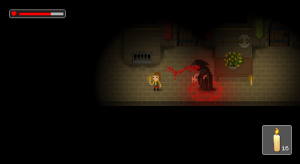
One of the most enjoyable elements to the gameplay is just how flexible the overall experience is. Your decisions near the start of the game in the moral dilemmas I mentioned earlier have the largest impact upon Hans’s adventure as, while you will never become stuck or otherwise locked out of completing the game, just which resources you have at your disposal can become significantly altered, which in turn affects the ways in which you can approach certain puzzles and just how difficult or easy many of the rooms are to complete. As important as these initial issues, and several more along the way, are to Hans’s journey, the exploration aspect itself contains a good bit of flexibility. Most of the doors in the castle are locked at the start, but the path is far from linear as these doors are merely color-coded; once Hans has a key, he gains access to every door with banners sharing that key’s color and many optional (and some not-so-optional) tasks in earlier rooms can only be completed with items found in later areas. As a final note on flexibility, time advances whenever Hans finds a letter and a large number of useful events and bits of dialogue can be completely missed if you only focus on rushing after the letters instead of taking the time to carefully scour the castle for clues and items.
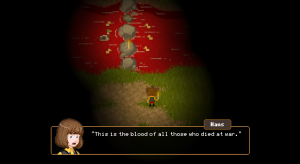
I would personally call The Count Lucanor a darkly-themed adventure game with puzzle and stealth elements rather than shoving it into the horror genre, in large part because it never feels like the game is trying to ‘scare’ players away from exploring its unsettling setting, but it is not completely devoid of some of this latter category’s trappings. These is no need to fear endless amounts of inventory management, but healing items are limited and gold is used both for buying several useful things and for saving the game at the courtyard’s fountain. That said, the food and coins of The Count Lucanor are a far cry from the herbs and ink ribbons of Resident Evil as chests and drawers containing these resources are so plentiful that you very well may have dozens of healing items left over by the end of the game and a rather significant pile of gold coins even if you buy every item you can and have a habit of saving after the most minor acts of progression. The classical horror limitations on resources are largely superficial, but Hans’s ability to defend himself against the multitudes of monstrous goats, masked servants, and other monstrosities is right in line with the genre standard. Namely, Hans is incapable of attacking and his abilities include walking slowly (a trait which makes the initial trek through the forest a bit tedious, though it is not an issue within the compact rooms and halls of the castle itself) and hiding behind curtains and under tables.
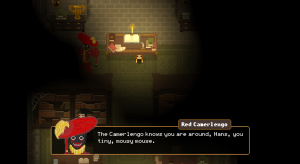
Sound and sight, or the lack thereof, are equally important to both the atmosphere and Hans’s survival. If you are as adverse to jump scares as I am then you have nothing to worry about as there is maybe one such event (and I hesitate to even go that far) in the entirety of this game as the focus is primarily upon building up a creepy atmosphere in a disturbing setting With the exception of the courtyard and a very small handful of other areas, the castle is pitch black and Hans must rely entirely upon a rather generous supply of candles and the occasional brazier for any form of light. Candles never go out and can be placed anywhere on the ground or picked back up, but your large supply can quickly dwindle away if you are careless about leaving them behind. In addition to helping to illuminate puzzles and to serving as markers in larger areas, candles are essential for spotting foes in advance, which is particularly important as just about every creature in the game can either move faster than Hans or can pull him closer. As for sound, the ominous steps, malicious whispers, and bestial cries are not only there to build tension (though they certainly do that!), but also to help prevent Hans from meeting an unfortunate demise. Every enemy in the game makes a unique sound and this is definitely a game you want to have headphones for because these sounds can also be used to determine how far away the enemy is and which direction it’s coming from even in complete darkness. Nothing about The Count Lucanor is likely to make you jump out of your seat or scream in surprise, but there is always a sense of muted dread whenever you’re adventuring into an unknown corner of the castle or, as I did multiple times, whenever you forget to place a candle on the ground before swapping to another item and suddenly find yourself plunged into complete darkness.
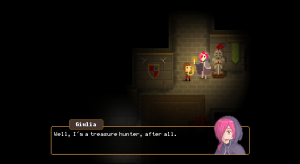
As far as downsides go, there aren’t all that many which I can think of as this is overall a small, well-paced, and focused experience. That said, the game is not completely without its flaws. Some bugs still need to be ironed out as a cutscene near the middle of the game had no sound at all during my playthrough and at one point Hans decided to pop up a dialogue box immediate right as I moved from a perfectly safe tile to a timed flame trap and let’s just say that things didn’t work out particularly well for Hans. The writing also has a handful of questionable moments, such as when Hans and his mother manage to use the word ‘really’ four times within three lines of dialogue and Hans himself seems to have a rather anachronistic fondness for shouting ‘zowie’. In terms of non-minor issues, the only one is probably the fact that enemies generally don’t feel very threatening. Yes, you want to avoid being noticed whenever possible and any given enemy can rapidly remove large chunks of Hans’s health, but your opponents just aren’t particularly bright. Enemies will never check under tables, even if you use one of these to hide right in front of a monster mid-chase and, as far as I can tell, they pay no attention to the light from Hans’s candle and only react to Hans himself. The servants which primarily populate the main hallway can be particularly nonthreatening as they outright will not take notice of Hans unless he is directly in front of them; you can even walk straight into them from behind or the side and they won’t so much as turn around. All the tension and suspense built by the great uses of sound and limited vision is somewhat undercut by just how easy it is to safely hide in the majority of situations.
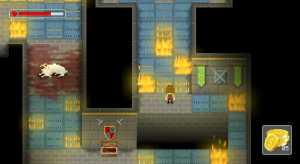
The Count Lucanor is not the next Five Nights at Freddy’s. It won’t make you jump out of your chair and scream frightened obscenities at your screen because that’s not its goal. What it does offer, however, is an exceptionally well-told dark fairy tale filled with interesting characters, compelling mysteries, an ominous atmosphere, and a surprisingly flexible design and I think that’s more than enough to mark it as a worthwhile experience and a great debut from the rather appropriately-named Baroque Decay Games.